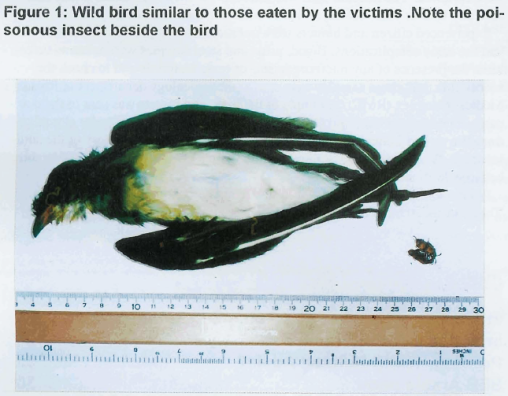Article Info
Authors
Year: 1999
Month: October
Issue: 4
Pages:
Reference:
, .Saudi Epidemiology Bulletin. 1999;6(4):.
On 15 of April 1999, eight Saudi men presented to the emergency department of King Khalid Hospital in Al-Majmaa region complaining of haematuria and dysuria after eating hunted wild birds. Those patients were spring camping in the north eastern part of KSA, about 150 km from Al-Majmaa province, this area is a spring time spot for Saudis particularly for hunting activities.
We initiated an epidemiological investigation and a retrospective cohort study was conducted to determine the extent and the source of this outbreak.
A case was defined as any person who developed haematuria and dysuria within three hours after eating a meal of wild birds on 15/4/1999.
Patients were interviewed directly and questioned about date, time of eating the meal, any food items eaten before or after it and symptoms. Medical records were reviewed. The hospital staff was interviewed, they were asked if they had seen any similar cases before, and if so what was their diagnosis.
Experienced citizen and hunters were questioned about previously persons who had the same complications. Blood, urine and stool samples were taken to determine the presence of any microorganisms or toxic materials and to check the kidney function, those samples were sent to the toxicology department at Riyadh Medical Complex (RMC). A sample of the birds and insects was sent to the department of Entomology and Ornithology at King Saud University for classification. We visited Tomer city in Al-Qassim Region, that have a history of the similar cases. We reviewed articles and reports written about cantharidin in literature between 1950 and 1999.
We found that: These men went to this remote area to hunt migrating birds, They cooked 20 birds in one pot immediately after killing them, removing the heads and feathers only, keeping the guts as part of typical hunter rituals. After three hours, five of the eight men reported symptoms of dysuria and hematuria; they had eaten meat, rice, and drank a lot of the soup while cooking before adding rice. The other 3 men who ate meat only had no complaint.
Three of the five men who suffered from cystitis were admitted to the hospital for three days. The severity of the symptoms differed from person to person according to the amount of rice or soup consumed those who drank a lot of soup had severe pain and difficulty urinating. Four patients who ate rice and had small amount of soup had less pain. One of the patients noticed insect parts in the gut of birds. There were no cases seen before in that hospital having same symptoms, the kidney function test and blood test were normal for all, the RBC count were detected microscopically in the urine.
These birds were the size of pigeons, and were known to feed on insects and beetles.
We found crushed parts of the blister beetles in the bird stomach after dissection.
The College of science identified the birds, the zoological name is Gloreol Barricade, the common name is Barricade, and the family name is Glareolinae. They also identified the insect and classified as: Insecta (Hexapoda ) order, Coleoptera and family , Meloidae.
Editorial note:
This documented indirect cantharidin food poisoning caused by eating wild birds has happened for the first time in the Kingdom of Saudi Arabia (KSA). Crushed blister beetles yield cantharidin (3:6 epoxy-1:2-dimethylcyclohexarie -1:2-dicarboxylic anhydride), an anhydrate of the simple aromatic acid, cantharidic acid, which was first isolated in 1810 [1]. The substance is an odorless and colorless crystal, poorly soluble in water, and slightly soluble in alcohol, acetone, ether, and fats. Cantharidine is an extreme irritant and vesicant long falsely but much smaller amounts can be life-threatening. Cantharidn circulates bound to albumin and is eliminated slowly by the kidneys.
The lethal dose in adults has been estimated to be anywhere from 10 to 80 mg but most commonly is reported to be less than 60mg [2].
The three men who only ate the meat of the bird were free of any symptoms, this can be explained that: This toxin dissolved and mixed with the food with the highest concentration in the soup and less in the rice and does not affect the meat of the birds. The migrating birds ingested insects which secrete a toxic chemical (cantharidine) as a defense mechanism which does not affect the bird's urinary system since some birds have no bladder (Cloaca).
The results of this study showed that: peoples are not aware of the dangerous health problems caused by unsafe handling of hunted birds. One of the most important prevention measures from cantharidin poisoning is removing the internal gut of birds before preparing them for cooking, because of the presence of insects in the gut and stomach. Hunters of birds should minimize hunting towards end of spring because of the increasing number of poisonous insects at that time. People who use traditional medicine in which these insects are combined J should stop using them, because the doses and poison in that combination is not well assembled and may result in renal failure or death.
References
- Presto AJ, Muecke EC: Adose of Spanish fly. JAMA 1970: 2141591-592
- Polettini A, Crippa 0, Ravagli A, Saragoni A: A fatal case of poisoning with cantharidin, Forensic Sci Int 1992;56:37-43
- Nickolls LC, Teare D: Poisoning by cantharidin. BMJ 1954;2:1384-1388
